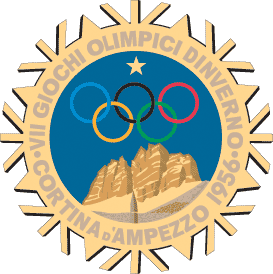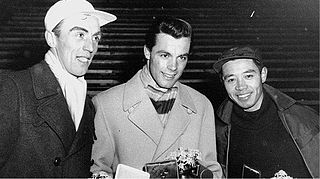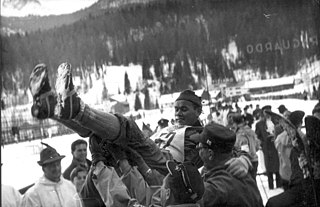
The 1956 Winter Olympics, officially known as the VII Olympic Winter Games and commonly known as Cortina d'Ampezzo 1956, were a multi-sport event held in Cortina d'Ampezzo, Italy, from 26 January to 5 February 1956.

Australia sent a delegation to compete at the 1956 Winter Olympics from the 26 January to 5 February 1956 in Cortina d'Ampezzo, Italy. This was the nation's third appearance at the Winter Olympic Games with their last appearance being in 1952.
At the 1956 Winter Olympics in Cortina d'Ampezzo, Italy, the six alpine skiing events were held from Friday, 27 January to Friday, 3 February.
Nordic combined at the 1956 Winter Olympics consisted of one event, held from 29 January to 31 January. The ski jumping portion took place at Trampolino Olimpico, while the cross-country portion took place at Lo Stadio della neve.
Ski jumping at the 1956 Winter Olympics consisted of one event held on 5 February The competition took place at the Trampolino Olimpico Italia with a K-Point of 72m.
The women's figure skating competition at the 1956 Winter Olympics took place at the Olympic Ice Stadium in Cortina d'Ampezzo, Italy. The competition was held on 30–31 January and 2 February 1956. Twenty-one women from eleven countries participated in the competition. The event was dominated by the American skaters and who won gold and silver. Tenley Albright, who overcame a significant injury two weeks before the start of the competition, was the Olympic champion.
The women's giant slalom at the 1956 Winter Olympics was held on 27 January in Cortina d'Ampezzo, Italy. It was run on the Canalone run on Mount Tofana. The course was 1,366 metres (4,482 ft) long with a 408 metres (1,339 ft) vertical drop. There were 46 gates that the women had to navigate. Forty-four women from sixteen countries competed. German skier Ossi Reichert won the event while Austrians won silver and bronze.
The men's giant slalom at the 1956 Winter Olympics was held on 29 January on Mount Faloria, outside Cortina d'Ampezzo, Italy. The course on the Ilio Colli run was 2.660 km (1.65 mi) in length, with a vertical drop of 623 metres (2,044 ft). There were 71 gates for the men to navigate on the course. Ninety-five men from twenty-nine countries entered the race though eight were disqualified. Austrian men swept the medals.
The women's slalom at the 1956 Winter Olympics was held on 30 January. It was run on the Col Druscie. The course was 456 metres (1,496 ft) in length with a 175 m (574 ft) vertical drop. There were forty-one gates on the first run and forty-five gates for the second run. Forty-eight women from sixteen countries entered in the race. Twelve women were disqualified during the two runs. Swiss skier Renée Colliard won gold over Austrian Regina Schöpf, who placed second, and Russian Yevgeniya Sidorova, who won the bronze.
The men's figure skating competition at the 1956 Winter Olympics took place at the Olympic Ice Stadium in Cortina d'Ampezzo, Italy. The competition was held on 29 January and 1 February 1956. Sixteen men from eleven countries participated in the competition. The event was dominated by the American skaters who swept the medals. Hayes Jenkins and his brother, David Jenkins, won gold and bronze respectively.

The men's slalom at the 1956 Winter Olympics was held on the Col Druscié run on Tuesday, 31 January. The course length was 617 metres (2,024 ft) with a vertical drop of 251 m (823 ft); the first run had 79 gates and the second had 92 gates. Fifty-seven athletes finished both runs and 23 were disqualified during the first run, and eight during the second. Twenty-nine countries were represented and Toni Sailer of Austria won the second of his three gold medals at these Games. Chiharu Igaya won the silver and Stig Sollander of Sweden took the bronze.
The women's downhill event of the 1956 Winter Olympics at Cortina d'Ampezzo, Italy, was held on Mt. Tofana on Wednesday, 1 February.

The men's 30 km cross country race at the 1956 Winter Olympics took place on 27 January. It was held at the Snow Stadium, which was about 2 km (1.2 mi) from Cotrina. Fifty-one competitors from eighteen countries participated in the event. Finnish skier Veikko Hakulinen won the event by only 24 seconds over Swede Sixten Jernberg. Hakulinen and Jernberg would switch positions on the podium in the 50 km (31 mi) event. Russian skier Pavel Kolchin won the bronze in the 30 km (19 mi) event and also in the 15 km (9.3 mi) event.
The ladies' 10 kilometre cross-country race at the 1956 Winter Olympics was held on 28 January. It was held at the Snow Stadium, which was about 2 km (1.2 mi) from Cortina. Thirty-seven competitors from eleven countries participated in the event. The Soviet Union won the top two spots when Lyubov Kozyreva edged teammate Radya Yeroshina by 5 seconds. Swede Sonja Edström won the bronze.
The men's 15 kilometre cross-country race at the 1956 Winter Olympics was held on 30 January. It was held at the Snow Stadium, which was about 2 km (1.2 mi) from Cortina. Sixty-one competitors from twenty countries participated in the event. The Nordic countries of Norway and Sweden took first and second in the form of Hallgeir Brenden of Norway and Sixten Jernberg of Sweden. This was Jernberg's second silver medal of the Games. Soviet skier Pavel Kolchin won his second bronze of the Games.
The ladies' 3 × 5 kilometre cross-country relay at the 1956 Winter Olympics was held on 1 February. It was held at the Snow Stadium, which was about 2 km (1.2 mi) from Cortina. Ten teams and thirty skiers participated in the event. Finland won the event. The Soviet team placed second and Sweden took the bronze.
The men's 50 kilometre cross-country race at the 1956 Winter Olympics took place on 2 February. It was held at the Snow Stadium, which was about 2 km (1.2 mi) from Cotrina. Thirty skiers from thirteen countries participated in the event. The Nordic countries once again dominated the event. In a reversal of the top two results in the 30 km (19 mi) race, Swedish skier Sixten Jernberg won the gold, Fin Veikko Hakulinen took the silver and Russian Fedor Terentjev won the bronze. Jernberg would go on to win a bronze in the relay event giving him a full complement of gold, silver and bronze. Hakulinen would win a silver in the relay event giving him a gold and two silver medals for the Olympics.
The men's 4 × 10 kilometre relay at the 1956 Winter Olympics took place on 4 February. It was held at the Snow Stadium, which was about 2 km (1.2 mi) from Cotrina. Fourteen teams and fifty-six skiers participated in the event. The Soviet team won the event. Finland came in second and Sweden took the bronze.
The men's figure skating competition at the 1952 Winter Olympics took place on 19 and 21 February at Jordal Amfi and Bislett stadion. The compulsory figures were held at Jordal Amfi, while the Free skating was contested at Bislett stadion. The ice surface at Bislett was set inside the oval created by the speed skating track. It was also an outdoor arena, which was used for the opening and closing ceremonies. There were no issues with the weather and the skating surface at Bislett was immaculate. Computers were used for the first time during the figure skating competitions to help tabulate the judges' marks and relay the results instantaneously.




